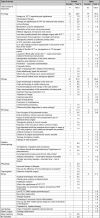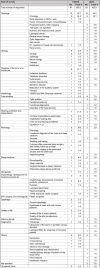Evidence gaps in ENT surgery - a qualitative survey
- PMID: 28025610
- PMCID: PMC5169083
- DOI: 10.3205/cto000137
Evidence gaps in ENT surgery - a qualitative survey
Abstract
Introduction: As in other disciplines, the burgeoning knowledge in ENT medicine long ago surpassed our ability to adequately absorb it and maintain a proper overview. This can give rise to actual or assumed evidence gaps that can impede the progress of the discipline and evidence-based treatment of patients. Clinics and medical practices also hold to traditional doctrines that shape day-to-day medicine, without these schools being challenged based on evidence. Methods: Between February and June 2015, 160 ENT clinics, including 34 university hospitals, and 2,670 ENT practices took part in a two-arm online survey on existing or perceived evidentiary gaps in ENT medicine using a previously developed questionnaire. The survey used for half of the participants was open in form; the other half were given a closed survey with systematics of the field for orientation. The survey was augmented with additional data such as the number of publications and focus areas in the clinics and the age and type of practice of the established physicians. Results: The return rate from the clinics was 39.7%; the return rate of the closed surveys was 29.3%. Of the physicians in medical practice, 14.6% responded to the closed and 18.6% to the open survey. There were no major differences between the two forms of survey. Otological and oncological issues comprised approximately 30% of the list of answers from clinics. Corresponding questions were formulated regarding the current diagnostic and therapeutic problems, such as with stage-related tumor treatment or implantable hearing aids. Diagnostic procedures, e.g., special new procedures in audiology and vestibulogy, dominated the surveys from the practices. However clinics and practices alike cited marginal areas of the discipline that are of daily relevance. Discussion: The cited evidence gaps then needed to be verified or refuted and clarified based on research of the literature as to whether the existing evidence actually reached healthcare providers in the form of guidelines, publications, conferences, or continuing training for application in daily practice. Other steps would include prioritizing future research, evidence mapping, deciding on further systematic reviews, and targeted studies in conjunction with procuring third-party funding and in cooperation with patient associations. The knowledge thus gained should ultimately be transferred in improved form for application in daily clinical practice. Ten questions of key importance each needed to be formulated for the hospitals and practices.
Keywords: ENT medicine; evidence gaps; evidence-based medicine; healthcare research; survey.
Figures















Similar articles
-
Evidence and evidence gaps - an introduction.GMS Curr Top Otorhinolaryngol Head Neck Surg. 2016 Dec 15;15:Doc11. doi: 10.3205/cto000138. eCollection 2016. GMS Curr Top Otorhinolaryngol Head Neck Surg. 2016. PMID: 28025611 Free PMC article. Review.
-
[Gaps of Evidence in ENT-Surgery - a Qualitative Survey].Laryngorhinootologie. 2016 Apr;95 Suppl 1:S13-37. doi: 10.1055/s-0041-108949. Epub 2016 Apr 29. Laryngorhinootologie. 2016. PMID: 27128398 German.
-
[Evidence and Evidence Gaps - an Introduction].Laryngorhinootologie. 2016 Apr;95 Suppl 1:S6-S12. doi: 10.1055/s-0041-108944. Epub 2016 Apr 29. Laryngorhinootologie. 2016. PMID: 27128405 German.
-
Evidence-based medicine Training: Kazakhstan experience.Int J Risk Saf Med. 2015;27 Suppl 1:S95-6. doi: 10.3233/JRS-150705. Int J Risk Saf Med. 2015. PMID: 26639732
-
Evidence-based medicine, systematic reviews, and guidelines in interventional pain management, part I: introduction and general considerations.Pain Physician. 2008 Mar-Apr;11(2):161-86. Pain Physician. 2008. PMID: 18354710 Review.
Cited by
-
Prevalence of hearing loss and use of hearing aids among children and adolescents in Germany: a systematic review.BMC Public Health. 2019 Sep 18;19(1):1277. doi: 10.1186/s12889-019-7602-7. BMC Public Health. 2019. PMID: 31533687 Free PMC article.
-
Evidence and evidence gaps - an introduction.GMS Curr Top Otorhinolaryngol Head Neck Surg. 2016 Dec 15;15:Doc11. doi: 10.3205/cto000138. eCollection 2016. GMS Curr Top Otorhinolaryngol Head Neck Surg. 2016. PMID: 28025611 Free PMC article. Review.
-
The prevalence of hearing loss and use of hearing aids among adults in Germany: a systematic review.Eur Arch Otorhinolaryngol. 2019 Apr;276(4):945-956. doi: 10.1007/s00405-019-05312-z. Epub 2019 Feb 9. Eur Arch Otorhinolaryngol. 2019. PMID: 30737583 Free PMC article.
References
-
- Dreier G, Löhler J. Evidenz und Evidenzlücken – eine thematische Einführung. [Evidence and Evidence Gaps – an Introduction]. Laryngorhinootologie. 2016 Apr;95 Suppl 1:S6–S12. doi: 10.1055/s-0041-108944. (Ger). Available from: http://dx.doi.org/10.1055/s-0041-108944. - DOI - DOI - PubMed
-
- Mulrow CD. Rationale for systematic reviews. BMJ. 1994 Sep;309(6954):597–599. doi: 10.1136/bmj.309.6954.597. Available from: http://dx.doi.org/10.1136/bmj.309.6954.597. - DOI - DOI - PMC - PubMed
-
- Blümle A, Meerpohl JJ, Wolff R, Antes G. Evidenzbasierte Medizin und systematische Übersichtsarbeiten: Die Rolle der Cochrane Collaboration. MKG-Chirurg. 2009;2(2):86–92. doi: 10.1007/s12285-009-0081-6. Available from: http://dx.doi.org/10.1007/s12285-009-0081-6. - DOI - DOI
-
- Schmucker C, Motschall E, Antes G, Meerpohl JJ. Methoden des Evidence Mappings – eine systematische Übersichtsarbeit. [Methods of evidence mapping. A systematic review]. Bundesgesundheitsblatt Gesundheitsforschung Gesundheitsschutz. 2013 Oct;56(10):1390–1397. doi: 10.1007/s00103-013-1818-y. (Ger). Available from: http://dx.doi.org/10.1007/s00103-013-1818-y. - DOI - DOI - PubMed
-
- Butzlaff M, Lutz G, Falck-Ytter C. Lernen ohne Ende. Die medizinische Leitlinie--ein Weiterbildungsinstrument mit Zukunft. [Learning without end. The medical guideline--an instrument for further education in the future?]. Dtsch Med Wochenschr. 1998 May;123(20):643–647. doi: 10.1055/s-0029-1233234. (Ger). Available from: http://dx.doi.org/10.1055/s-0029-1233234. - DOI - DOI - PubMed
Publication types
LinkOut - more resources
Full Text Sources
Research Materials
Miscellaneous

